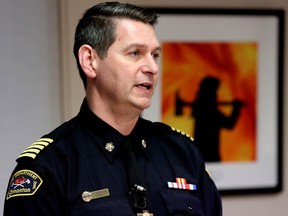Edmonton Fire Chief Joe Zatylny said 70 per cent of the 95,496 calls to Edmonton Fire Rescue Services (EFRS) in 2023 were medically related

Article content
Edmonton’s fire department says it’s reducing their call burden by only responding to urgent medical needs as part of a plan to cut down the number of firefighters going to medical-related calls.
Edmonton Fire Chief Joe Zatylny provided a report to the community and public services committee on Monday. He said 70 per cent of the 95,496 calls to Edmonton Fire Rescue Services (EFRS) in 2023 were medically related. The service is projecting up to 80,000 medical calls per year by the end of 2024 — assuming the trend continues.
Advertisement 2
Article content
Article content
Zatylny said since 2018 the service has had a series of challenges which have “risen to the forefront at unprecedented levels,” which include encampments, the COVID-19 pandemic, wildfire preparedness, and most recently, arson tied to extortion schemes.
“These factors have all put pressure on resources, increasing our total calls for responses to over 90,000 calls. This is about prioritizing critical life threatening and time critical emergencies and making sure we are there for all Edmontonians when they need us when seconds count being in the right place at the right time,” he said.
Mayor Amarjeet Sohi asked if the “life-saving” service being provided by EFRS was filling the gap from Emergency Medical Services (EMS) and if without it someone might die. Members of the service responded saying without them, the risk would increase.
“There is no ambiguity on health in Alberta. Health is the sole responsibility of the province. I’m pretty sure this government will be open to looking at strong data that we can put together that would actually demonstrate that we are actually filling that gap,” Sohi said.
Advertisement 3
Article content
If the same service being provided by EFRS were to be funded by EMS it would cost $422 per half an hour,, according to information provided by city staff Monday. Overall it would come to $28-million a year if Alberta Health Services paid the city for providing the medical care. It would represent about a 1.5 per cent tax reduction.
Between 2018 and 2023 medical related call have increased by 82 per cent.
Four-point plan
The four-point action plan created in partnership with AHS Medical First Response program will take from the end of March to the end of June to be implemented.
By the end of March, EFRS will revise their lift assist protocol to align with the Calgary Fire Department. This will, according to the report, free up capacity for the service by limiting response for lift assists in support of on-scene EMS units to when paramedics need time-critical assistance and in non-urgent situations, to when all other EMS resources are tasked.
In May, EFRS will then align with Calgary to modify their pre-alert processes between dispatch centres by removing pre-alert notifications on events except those deemed life-threatening. EFRS officials will additionally work with AHS to amend the medical response plan to reduce the types of calls its responds to, which they estimate will reduce medical call volume for the service by 31 per cent.
Lastly in June, in collaboration with AHS, EFRS will co-develop a response to strategies for high-frequency locations to reduce need for immediate medical response prior to EMS arrival.
X: @kccindytran
Recommended from Editorial
Article content





